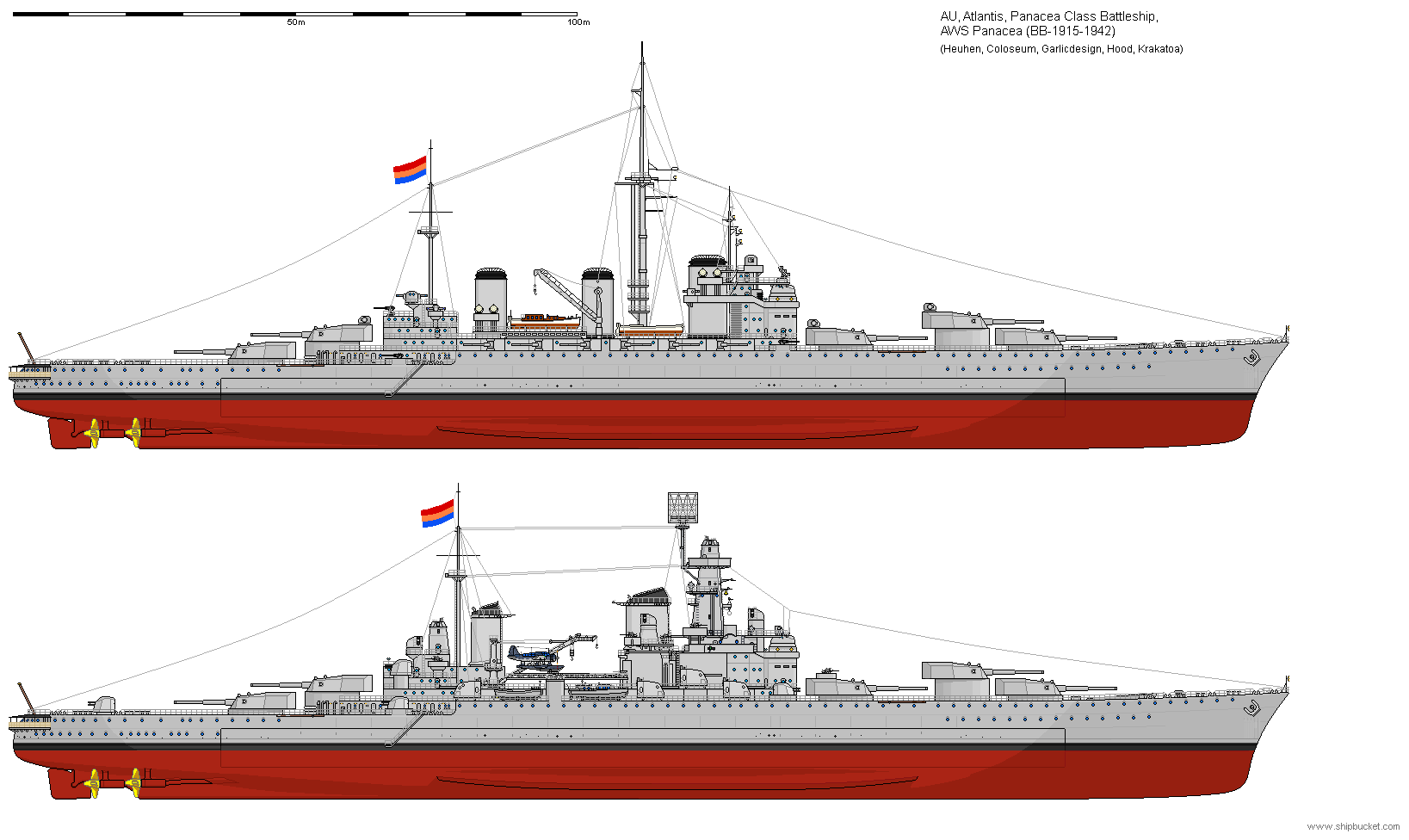1911, the Admiralty have the Ares and Hera under construction, but are looking to put their next battleship into production. They have the 16" gun plans on the board, but they will not be ready in time for any new ship(s) laid down now. The best the Admiralty designers could come up with was a ship with one more turret than the Ares class and make them all with a uniform triple turret. Yes an armament of fifteen 14" was being thought of. Not only thought of but put into production. With the European War looking to be about to explode, the Panacea was laid down under a double shift order. This shortened the normal 5 year cycle of production down to under 4 years. Laid down in late 1911, the Panacea was completed early in 1915.
As completed 1915:
Displacement: 34,500 tons standard, 41,500 tons full load.
Dimensions: 741 x 98 x 28 feet.
Machinery: 4 shaft, oil fired turbines, 90,000shp
Speed: 27 knots
Endurance: 10,000 miles at 14 knots
Armour: 13" belt, 3" deck, 14"/9" turrets.
Armament:
15 x 14" (5x3)
12 x 5.5" (12x1)
4 x 75mm AA
Crew: 1450

Because of its superior speed compared to most of Beatty's battlecrusers, the Panacea joined the 2nd Battlecruiser Squadron based at Rosyth. Panacea missed the 1915 battlecruiser battles and joined in time to cover those ships that had received damage at Dogger Bank. 1916 and the Panacea is at Jutland. Placed in behind Admiral Moore's flagship HMS New Zealand in the 2nd Battlecruiser Squadron the Panacea made short work of the German battlecruiser Yorck, that just could not take the concentrated fire of Panacea's fifteen 14" guns. The Yorck heeled out of the line and headed away from the battle, never to be heard of again. Sometime in the next 40-45 minutes the Yorck heeled over and sunk. The Panacea switched fire but it was now firing at ships that had other Allied ships also firing at them. This made it very difficult to spot the fall of shot and during this period of the battle the Panacea was more or less just firing for effect. The Queen Mary exploding and sinking just up the battlecruiser line had a salutary effect on the Atlantean observers. Their policy not to build the type was certainly vindicated with three of the type exploding so spectacularly around them. The Captain of Panacea (John Cook) sent in a report criticising the handling of the Battlecruiser Fleet during the Jutland action which was received, acknowledged, and sat on by the Admiralty. No taint was to smear their new hero Admiral Beatty.
During the 1920's and 1930's, the Panacea received minor modifications during its scheduled refit periods. Adding AA guns and better gunnery control optical equipment. The ship was slated for a full rebuild in 1939-40, but the outbreak of war saw the Panacea go to war in a less than satisfactory state.
1941 and the Panacea is part of the Group Six force hunting for the Scharnhorst and Gneisenau. Group six makes contact with S&G at 3.45pm on an October afternoon under lowering skies with squalls passing through. Less than ideal conditions. The Panacea has the battleship Hephaestus with its 6x16" as force commanders ship. The two battleships should be more than a match for S&G with their 9x13.8" (see AU S&G in DPKM). Early in the battle the Hephaestus receives three hits around the aft triple 16" turret which puts it out of action, and halving its broadside. The Panacea now proved that even with its antiquated look it could deal with any of the more modern upstarts. In just four broadsides the Panacea hit Gneisenau with 12 fourteen inch shells, forcing Gneisenau to be ordered to withdraw with Scharnhorst covering. One more salvo this time at Scharnhorst hit Scharnhorst with four 14" hits causing damage that Admiral Marschall decided was enough, and ordered both S&G into the oncoming storm where their superior speed took them quickly out of sight. Panacea had not got away scot free from the battle and fires in the central superstructure took some time to contain. While both ships could still fight and searched for S&G most of the next day, the Atlantean Admiralty ordered both ships to Norfolk Navy yard where their damage would be repaired and Panacea would receive its much needed refurbishment via Lend Lease at the American yard.
As rebuilt under Lend Lease 1941-42:
Displacement: 35,200 tons standard, 44,700 tons full load.
Dimensions: 741 x 98 x 28 feet
Machinery: 4 shaft, oil fired, (new) 110,000shp
Speed: 28 knots
Endurance: 12,000 miles at 14 knots.
Armour: 13" side, 6" deck, 14"/9" turrets.
Armament:
15 x 14" (5x3)
16 x 5" (8x2)
32 x 40mm (8x4)
10 x 25.4mm (5x2)
Aircraft: 4
Crew: 1520